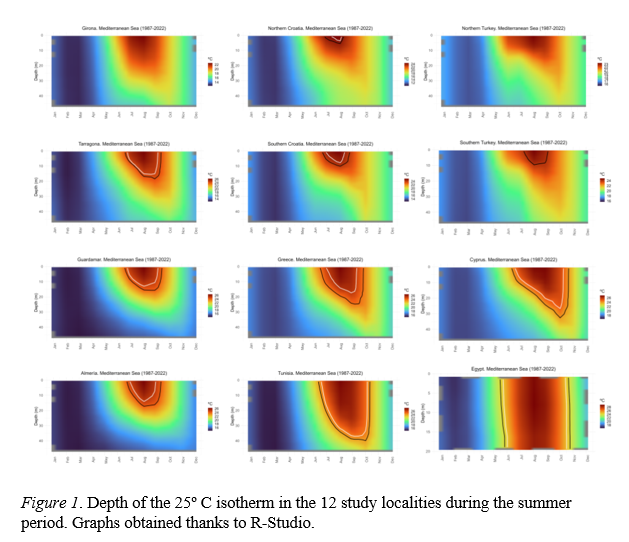CLIMATE-DRIVEN SHIFTS IN WATER COLUMN STRATIFICATION AND THEIR EFFECTS ON MEDITERRANEAN FINFISH FARMING
Introduction
Due to the increase of CO₂ emissions and other greenhouse gases, the oceans are experiencing warming caused by the global phenomenon known as climate change . This effect is especially evident in enclosed seas such as the Mediterranean . In this context , marine heat waves have become an increasingly frequent and intense phenomenon , seriously affecting the stability of marine ecosystems . In this context of climate change , activities such as marine aquaculture are subject to multiple stre ss factors such as those exerted by global climate change , an effect that affects the physiology , development and growth of fish species .
Material and Methods
Using data from Copernicus Marine Services , this study examines the effects of climate change on the thermal structure of the water column along a latitudinal and longitudinal gradient in the Mediterranean . The research focuses on 12 marine aquaculture sites in different countries (Spain , Tunisia , Greece , Croatia , Turkey , Cyprus and Egypt ). Specifically , it analyzes seasonality over two periods (a period before and a period after relevant effects of climate change ), as well as the evaluation of thermal anomalies during the summer season . To determine the sustainability of marine aquaculture systems throughout the Mediterranean , a climate risk indicator using R Studio will be applied to these locations , together with the interpretation of water column graphs .
Results and Conclusions
Thanks to the study of the thermal stratification in the water column , the deepening of the 25º C isotherm influenced by latitude and longitude is detected . The study of two different periods helps to find differences in the deepening of the isotherm , where warm water masses reach greater depths in the period more influenced by climate change , as well as their increasingly earlier appearance in the summer period (Figure 1) (Table 1). The locations of Guardamar (Spain ), Ionian Islands (Greece ) and Limassol (Cyprus ) take the highest values of isotherm deepening in the study period following global warming , with values of 14, 16 and 19 depth-month units , respectively . Specifically , locations located in the eastern Mediterranean area have a higher number of depth anomalies in the summer period . In addition , temperature-based climate risk indices indicate that locations in this area indicate high risk (values greater than 0.7-0.8) in terms of the sustainability of the aquaculture season and potential impacts , such as the Nile River (Egypt ) and Limassol (Cyprus ).
The continuous increase in mean ocean temperature and the intensification of marine heat waves could significantly affect European aquaculture , as heat stress compromises production . Thermal stratification limits the circulation of nutrients and oxygen , affecting the health and productivity of aquatic crops . Therefore , the sector must adapt to changes in marine ecosystem services to maintain sustainable production . It is crucial to develop climate change management and mitigation strategies in the Mediterranean region in order to have the tools to face these challenges and maintain optimal conditions in aquaculture systems .
References
Atalah , J., Ibañez , S., Aixalà , L., Barber , X., & Sánchez-Jerez, P. (2024). Marine heatwaves in the western Mediterranean : Considerations for coastal aquaculture adaptation . Aquaculture, 588, 740917.
Mengual , I. L., Sanchez -Jerez, P., & Ballester-Berman, J. D. (2021). Offshore aquaculture as climate change adaptation in coastal areas : sea surface temperature trends in the Western Mediterranean Sea. Aquaculture Environment Interactions, 13, 515-526.
Acknowledgments
This study forms part of the ThinkInAzul programme (https://thinkinazul.es/ ) and it was supported by MCIN with funding from the European Union NextGenerationEU (PRTR-C17⋅I1) and Generalitat Valenciana (THINKINAZUL/ 2021/044-TOWARDS).
